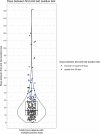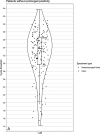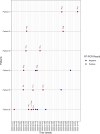Longitudinal SARS-CoV-2 Testing among the Unvaccinated Is Punctuated by Intermittent Positivity and Variable Rates of Increasing Cycle Threshold Values
- PMID: 35315712
- PMCID: PMC9045176
- DOI: 10.1128/spectrum.02715-21
Longitudinal SARS-CoV-2 Testing among the Unvaccinated Is Punctuated by Intermittent Positivity and Variable Rates of Increasing Cycle Threshold Values
Abstract
The coronavirus disease 2019 (COVID-19) pandemic is complicated by cases of vaccine breakthrough and reinfection and widespread transmission of variants of concern (VOCs). Consequently, the need to interpret longitudinal positive severe acute respiratory syndrome coronavirus 2 (SARS-CoV-2) tests is crucial in guiding clinical decisions regarding infection control precautions and treatment. Although diagnostic real-time reverse transcription (RT)-PCR tests yield CT values that are inversely correlated with RNA quantity, these tests are only approved for qualitative interpretation. In this study, we performed a retrospective review of 72,217 SARS-CoV-2 positive tests and identified 264 patients with longitudinal positivity prior to vaccination and VOC circulation. Patients with longitudinal positivity fell into two categories: short-term (207, 78%) or prolonged (57, 22%) positivity, defined as ≤28 (range, 1 to 28; median, 16) days and >28 (range, 29 to 152; median, 41) days, respectively. In general, CT values increased over time in both groups; however, 11 short-term-positive patients had greater amounts of RNA detected at their terminal test than at the first positive test, and 6 patients had RNA detected at CT values of <35 at least 40 days after initial infection. Oscillating positive and negative results occurred in both groups, although oscillation was seen three times more frequently in prolonged-positive patients. Patients with prolonged positivity had diverse clinical characteristics but were often critically ill and were discharged to high-level care or deceased (22%). Overall, this study demonstrates that caution must be emphasized when interpreting CT values as a proxy for infectivity, a predictor of severity, or a guide for patient care decisions in the absence of additional clinical context, particularly among the unvaccinated population. IMPORTANCE We describe the duration of positivity and the COVID-19 treatment and outcome characteristics of an unvaccinated population of patients with prolonged SARS-CoV-2 positivity. This investigation serves to highlight challenges in using CT values to guide clinical decisions among unvaccinated individuals.
Keywords: SARS-CoV-2; cycle threshold; infectivity; longitudinal positive.
Conflict of interest statement
The authors declare no conflict of interest.
Figures




Similar articles
-
[P323L Mutation in a Case with Prolonged SARS-CoV-2 PCR Positivity].Mikrobiyol Bul. 2023 Jul;57(3):490-497. doi: 10.5578/mb.20239941. Mikrobiyol Bul. 2023. PMID: 37462312 Turkish.
-
[Evaluation of the Rapid Antigen Detection Kit with the Polymerase Chain Reaction for Detection of SARS-CoV-2 in Respiratory Samples].Mikrobiyol Bul. 2022 Apr;56(2):263-273. doi: 10.5578/mb.20229806. Mikrobiyol Bul. 2022. PMID: 35477229 Turkish.
-
[Longitudinal Monitoring of Seroconversion Status in SARS-CoV-2 RT-PCR Positive Healthcare Workers].Mikrobiyol Bul. 2022 Jan;56(1):114-123. doi: 10.5578/mb.20229910. Mikrobiyol Bul. 2022. PMID: 35088965 Turkish.
-
Differentials of SARS-CoV-2 Viral RNA Re-positivity in Discharged COVID-19 Patients.AIDS Rev. 2021 Jun 3;23(3):153-163. doi: 10.24875/AIDSRev.21000023. AIDS Rev. 2021. PMID: 34082440 Review.
-
[SARS-CoV-2 and Microbiological Diagnostic Dynamics in COVID-19 Pandemic].Mikrobiyol Bul. 2020 Jul;54(3):497-509. doi: 10.5578/mb.69839. Mikrobiyol Bul. 2020. PMID: 32755524 Review. Turkish.
Cited by
-
Does the COVID-19 Vaccination Reduce the Risk to Transmit SARS-CoV-2 to Others?Adv Exp Med Biol. 2024;1457:247-264. doi: 10.1007/978-3-031-61939-7_14. Adv Exp Med Biol. 2024. PMID: 39283431 Review.
-
Reinfection with SARS-CoV-2 in a patient undergoing chemotherapy for lymphoma: Case report.J Assoc Med Microbiol Infect Dis Can. 2022 Sep 27;7(3):283-291. doi: 10.3138/jammi-2021-0036. eCollection 2022 Sep. J Assoc Med Microbiol Infect Dis Can. 2022. PMID: 36337604 Free PMC article.
References
-
- Li X, Xu S, Yu M, Wang K, Tao Y, Zhou Y, Shi J, Zhou M, Wu B, Yang Z, Zhang C, Yue J, Zhang Z, Renz H, Liu X, Xie J, Xie M, Zhao J. 2020. Risk factors for severity and mortality in adult COVID-19 inpatients in Wuhan. J Allergy Clin Immunol 146:110–118. doi:10.1016/j.jaci.2020.04.006. - DOI - PMC - PubMed
-
- Avanzato VA, Matson MJ, Seifert SN, Pryce R, Williamson BN, Anzick SL, Barbian K, Judson SD, Fischer ER, Martens C, Bowden TA, de WE, Riedo FX, Munster VJ. 2020. Case study: prolonged infectious SARS-CoV-2 shedding from an asymptomatic immunocompromised cancer patient. Cell 183:1901–1912.e9. doi:10.1016/j.cell.2020.10.049. - DOI - PMC - PubMed
-
- Baang JH, Smith C, Mirabelli C, Valesano AL, Manthei DM, Bachman M, Wobus CE, Adams M, Washer L, Martin ET, Lauring AS. 2021. Prolonged severe acute respiratory syndrome coronavirus 2 replication in an immunocompromised patient. J Infect Dis 223:23–27. doi:10.1093/infdis/jiaa666. - DOI - PMC - PubMed
-
- Xu K, Chen Y, Yuan J, Yi P, Ding C, Wu W, Li Y, Ni Q, Zou R, Li X, Xu M, Zhang Y, Zhao H, Zhang X, Yu L, Su J, Lang G, Liu J, Wu X, Guo Y, Tao J, Shi D, Yu L, Cao Q, Ruan B, Liu L, Wang Z, Xu Y, Liu Y, Sheng J, Li L. 2020. Factors associated with prolonged viral RNA shedding in patients with coronavirus disease 2019 (COVID-19). Clin Infect Dis 71:799–806. doi:10.1093/cid/ciaa351. - DOI - PMC - PubMed
MeSH terms
Substances
LinkOut - more resources
Full Text Sources
Medical
Miscellaneous

